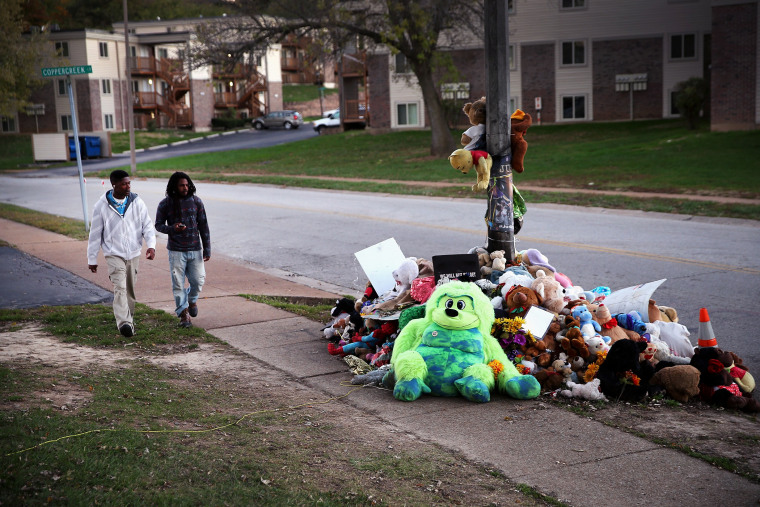After details from an official autopsy on Michael Brown were exposed to reporters, legal counsel for Darren Wilson, the officer who shot and killed the slain teen, spoke out for the first time since the investigation, saying "we were not responsible for any leaks to any media including those published in the NY Times and the St. Louis Post Dispatch."
The Thursday morning statement went on to say: "Further, we are not in possession of any of the disclosed reports or the investigative report. Finally, as long as the Grand Jury continues to meet and the Department of Justice continues to investigate, any commentary on this matter should only be done in the appropriate judicial venue and not through the media."
Hours after the details were published -- which could bolster his killer's claim of self-defense -- one of the experts whose analysis was central to those claims told msnbc that her analysis of the findings had been taken out of context.
“You cannot interpret autopsy reports in a vacuum. You need to do it in the context of the scene, the investigation and the witness statements,” Dr. Judy Melinek said. “Sometimes when you take things out of context they can be more inflammatory.”
The report, obtained and published by the St. Louis Post-Dispatch on Wednesday, provides the most detailed account of Brown’s injuries from the Aug. 9 shooting in Ferguson, Missouri, in which police officer Darren Wilson fatally shot the unarmed teen.
The findings align closely with an autopsy performed at the request of Brown’s family in late August, indicating Brown had been shot at least six times and suffered wounds to the head, upper body, arm and hand. This latest report indicates Brown suffered six entry wounds and three exit wounds.
But there is one key difference in the two reports -- a discrepancy that could likely shape the perception of the events that led to Wilson’s killing of Brown.
The private autopsy, conducted by renowned forensic pathologist Dr. Michael Baden, found that Brown’s wounds, including a wound to his right hand, suggested Wilson had been one foot to 30 feet away when he shot Brown -- a distance not considered close range.
RELATED: How the crisis in Ferguson unfolded, in photographs
This latest autopsy, conducted by the St. Louis County Medical Examiner, shows that the wound to Brown’s hand was inflicted at a much closer range. Those findings support Wilson’s narrative -- gleaned by county investigators -- that he had first shot Brown during a struggle at the officer’s vehicle when Brown reached for Wilson’s gun.
Wilson unholstered his weapon and “the weapon was discharged during the struggle,” the investigators said.
There is no dispute that a struggle between the two men took place at the car. The question is whether Brown reached for Wilson’s gun during the altercation and whether he was the aggressor.
According to the report, Wilson fired twice inside his vehicle, striking Brown before he fled the vehicle and was shot down by Wilson moments later.
A pair of experts, including Melinek -- a forensic pathologist from San Francisco -- and St. Louis medical examiner Dr. Michael Graham, told reporters on Wednesday that Brown’s wounds were consistent with Wilson’s explanation of events.
Later that day, Melinek told msnbc that her words had been partly misconstrued.
Melinek said that she had compared the forensic evidence included in the official autopsy report and Wilson’s statements and found them consistent. Since the report indicated the wound to Brown’s right thumb was close and in line to the barrel of Wilson’s gun when it discharged, it could mean he had been reaching for the gun.
“I’m not saying that Brown going for the gun is the only explanation. I’m saying the officer said he was going for the gun and the right thumb wound supports that,” she said. “I have limited information. It could also be consistent with other scenarios. That’s the important thing. That’s why the witnesses need to speak to the grand jury and the grand jury needs to hear all the unbiased testimony and compare those statements to the physical evidence.”
Melinek said that interpreting the forensic findings is often subjective.
“If other witnesses have statements as to where [Brown’s] hands were, they could also be consistent with the forensic findings if they line up with the injury trajectory and distance,” she said.
Melinek added that the only statement she compared to the forensic evidence was that made by Wilson and that a number of other scenarios could also be possible, including Brown trying to protect himself or his hands for whatever reason being near the muzzle of Wilson’s gun.
The new autopsy also found the fatal shots had come from a downward motion into the top of Brown’s head. Another gunshot struck Brown in the forehead, a third to his chest, two in his upper arm and one two the back of his forearm.
All but one of the gunshots, Melinek said, seem to have struck Brown in the front of his body, which is consistent with witnesses who said Brown had been facing Wilson when he was shot. Depending on any witnesses physical proximity to the shooting, Brown could have been turning to Wilson in surrender, stumbling toward him after being shot or charging him.
The shot to the back of Brown’s upper arm, Melinek said, suggested he could have been shot from behind.
Nearly a half-dozen witnesses say that after an initial altercation at Wilson’s car, Brown fled and that Wilson gave chase, firing at him from behind. At one point, they say, Brown turned with his hands up and Wilson fired the final, fatal shots. Unnamed sources quoted in both local and national news reports say Wilson has testified that he fired twice from his car and several times after Brown ran, turned, and then charged at him.
